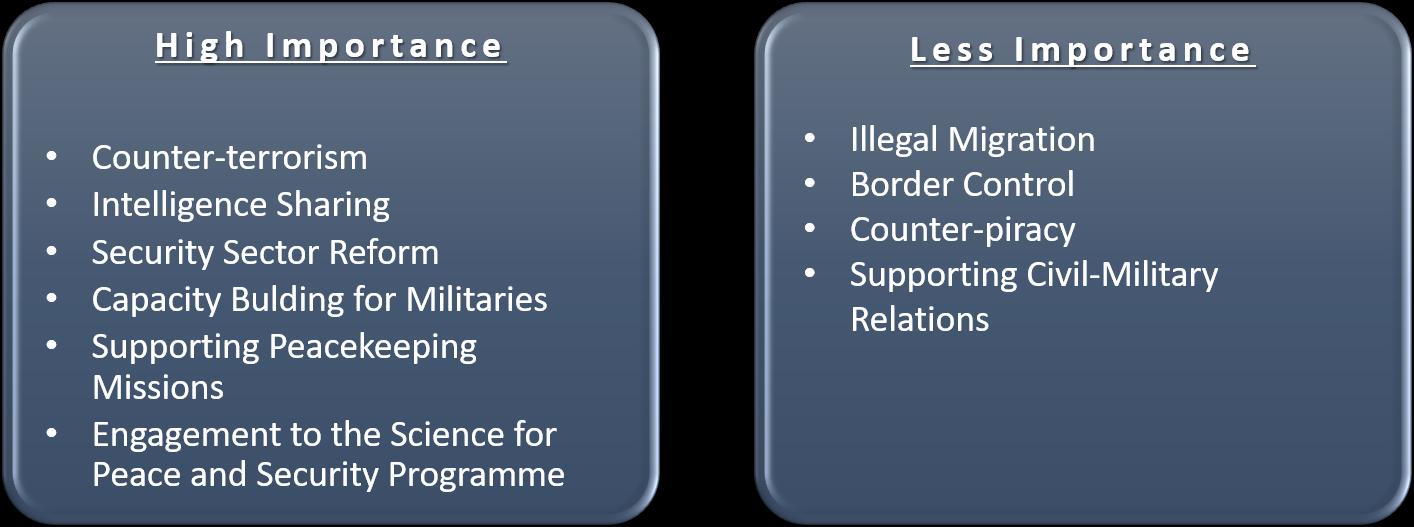OPEN PUBLICATIONS -
What would be the priorities for African countries in its relations with NATO?
b. Methodology
The Delphi technique has primarily been utilized to analyze current issues and their potential solutions in the future. The method was developed by Olof Helmer, Nicholas Rescher, Norman Delkoy and others in 195912 and the first paper using Delphi Research was published in 1964, entitled “Report on a Longrange Forecast.”13 Essentially, the Delphi Method allows researchers to analyze and forecast with high levels of accountability and reliability. The technique first identifies the experts to be included into the research; later it implements at least two rounds of survey, and if needed it is possible to execute subsequent rounds. In the first round, which uses open ended questions, experts articulate themselves independently on a specific subject and reflect their expertise on a specific issue without any reservations. At the conclusion of first round, the researcher should then develop a second round of surveys, or interviews, based on the first-round responses. In the second round, a multiple-choice questionnaire is deemed to be preferable. The rounds can be in person or online but should not take the form of an open discussion amongst the experts, who instead remain separate. The reasoning behind the decision to keep the experts isolated from one another in their responses is the asserted belief that open discussion between experts would potentially mean that the researcher loses her/his control of the process and the responses, so instead the method aims to prevent such biases. The key for success of the method is based on the initial expert selection. The Delphi technique is not a statistical method to produce a universal, fully representative sample. Instead, it is about the expertise of the limited group of responders. If it were a statistical method, the researcher would have needed a proper representative sample of those who are engaged in the subject or area. However, in Delphi technique, this is not necessary, because the technique allows the researcher to benefit from the experts ’knowledge on the specific subject. As a result, the selection of experts, the degree of their expertise for the research, the amount of the responders as well as their acceptance rate matters. Generally speaking, 15 to 35 people as respondents is desirable, with the invitation acceptance rate of between 40 and 75 per cent being considered satisfactory.14 The disadvantage of this method is that it takes time to implement regarding the aforementioned multiple rounds of surveys with experts. One should recognize that the Delphi technique is not presenting an accurate forecast, yet it has a capacity to present instead an educated assessment on the future of a specific subject. Essentially, in the case of this research activity the Delphi technique has been applied in two rounds. In the first round a structured, open-ended essay-style survey was distributed to the selected experts drawn from throughout the South and, after analysis of the first round, a second survey was prepared 12
Helmer, Olaf and Rescher, Nicholas, “On the Epistemology of the Inexact Sciences,” Management Sciences, Vol. 6, No.1, 1959. 13 Gordon, T.J., and Helmer, Olaf, Report on a Long-Range Forecasting Study, RAND Corp., R-2982, 1964. 14 Gordon, T.J., “The Delphi Method,” Futures Research Methodology, Vol.2, Issue.3, 1994, p. 7 (pp.1-30)
9





